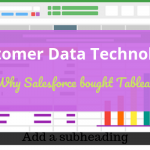
Going All In: An ABM Case Study
Time to read: 5 Minutes
Transitioning to Account-based Marketing (ABM) isn’t a software upgrade; it’s a total marketing system overhaul. So what is all the fuss about? Why transition from the good ol’ funnel? It’s a recipe for fast growth. According to this ABM case study, it:
- opens up a global market
- allows for competition with big companies
- widens the net for inbound leads
- introduces a transactional-enterprise shift – which means improved retention and leads
Game-changing? Most definitely.
Here’s a few interesting things gleaned from the ABM case study presented at the MarTech Magnified Conference 2018 by Jodi Lebow of CollabNet. She gave us the low-down on what happened when her company took the plunge. The results were eye-opening, to say the least.
Remember ABM Is About the Bigger Picture
While treating ABM as just another tool in the tech stack might make sense at first, there’s one important thing to consider. It’s not just a campaign, or a specific technology. ABM is a big-picture transformation. It unites marketers and sales in one strategic approach.
In other words, teamwork makes the dream work when it comes to integrating ABM, and the potential for multi-channel success is absolutely massive.
Bring Your Yardstick
Keeping your finger on the pulse of ABM is vital, so you’ll want to measure from day one. You don’t wanna miss out on that juicy data, do you? You shouldn’t, because you’ll risk losing comprehension of how each aspect of ABM integration is affecting your business.
Make sure that, at all times, you can account for the growing changes in the major areas:
- Awareness
- Engagement
- Reach
- Impact
This way, you’ll be able to consistently adjust your overall strategy as the need may arise, and keep those vital cogs in the marketing machine working together in perfect harmony.
Crunch the Numbers
Hey, you’re already collecting it; put it to work! Knowing how to apply your information to your accounts is key. Tier your accounts based on fit and engagement, and then adjust the verticals according to the data. This cuts down on time and resources that may otherwise be wasted throwing irrelevant data at individual accounts, and hoping something sticks.
Wanna get the most out of your information? Take some time to understand it, and put the numbers to work. Buying flowers and holding the door open won’t work for every account here; let the data tell you how they’d like to be courted.
Align SDRs and Marketing
Don’t wait for a barrage of form-fills to be inbound. By copping an all-bound strategy, your campaign can hit several different targets and efficiently bring in those sweet, sweet leads. If your sales dev team is on the same page as your marketing mavens, then the search for relevant information suddenly becomes a whole lot more inclusive.
Get Personal with Personalization
Personalization is more than just a fancy term for monogramming your suitcase. It’s a huge part of executing a successful ABM strategy, and one of the best uses of the aforementioned sweet, sweet data.
So create an insights machine within your SDRs. Give them a class in Buyer 101 and teach them what they need to know. Keeping it relevant, targeted and on-topic can make all the difference in the quality of an account, whether they’re interacting with you via direct mail, landing pages, targeted ads or the various aspects of SDR outreach.
Summing Up the ABM Case Study
Within ABM, it’s necessary to constantly adapt – be flexible in almost all areas of marketing. Mistakes will be made, some approaches will work better than others or not at all. At the end of the day, as with any race, it’s all about building momentum. So what are you waiting for? Start sprinting.
Or, as Jodi said in her ABM case study: “Get started. Experiment. Learn. Get better”.
Hey There…thanks for stopping by! Help your friends by hitting those share buttons!








